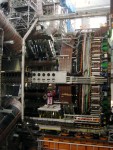Director's Corner
21 November 2007
 Barry Barish |
The importance of carefully planned infrastructure
Last week, I gave a colloquium about the ILC at CERN. This is a very interesting time to be at CERN. There is a buzz in the air and an impressive amount of intense activity, as final preparations are underway for the LHC start-up, scheduled for next summer. I had the opportunity to see much of this activity first hand, both for the accelerator and the experiments. Of course there is much for us to learn from the LHC: the scale is comparable to that of the ILC and many of the issues and even some of the technology are similar. As we begin to undertake our own detailed technical design for the ILC, we want to be as realistic as possible. From that standpoint, the single strongest impression I took away from this visit to CERN is the sheer magnitude of the infrastructure required to support these facilities.
When we think of the LHC, we picture the endless string of magnets in the ring and the gigantic detectors. Somewhat less obvious, but equally impressive, is the extensive infrastructure that is being implemented to support the accelerator and detectors. For example, the detector halls have complex structures enabling access to the detectors, elaborate cooling systems to bring the heat out, enormous cable plants to bring power to and signals from the detectors, big computer farms to handle the data, and much more. The ATLAS detector is almost completed and much of this elaborate final infrastructure is clearly evident. The CMS detector group is busy installing the last big pieces and simultaneously completing the associated infrastructure.
The machine infrastructure is equally important, but maybe not quite as evident to the eye, as it is spread out along the 27-kilometre ring. However, CERN has built an elaborate new control room for the LHC and the rest of CERN's accelerator infrastructure, bringing together everything from the controls for the accelerator itself to the monitors for the main services, like the cryogenics systems. Having all of this in one control area promises to bring about efficiency in personnel, as well as an invaluable means of communicating directly between all of the different systems that must work together to make the machine operational.
Bringing into operation such a large complex instrument as the LHC is quite a challenge. The detailed plans are constantly being thwarted by problems that occur in bringing all of these technical areas into operation on the planned schedule. So far, CERN management and staff have been able to solve these problems as they occurred and to develop the "workarounds" to maintain a schedule. They will undoubtedly run into more difficult problems as they bring the machine into operation, but hopefully they will be able to continue to maintain the ability to work through the problems. The carefully planned, flexible and powerful monitoring systems should be a great asset in accomplishing these goals.
For the ILC, we are watching the LHC very closely. It will be a valuable sanity check on our own designs, and we will profit from the "lessons learned" from their real-world experiences. As we enter into our engineering design phase, including "value engineering" to optimise cost to performance, we must remain very mindful of the importance of investing in infrastructure. We must also have a well planned and reliable set of services to support our facilities.
I very much appreciate the hospitality given to me at CERN. I believe I have come away with a heightened awareness of what is involved in implementing a complex accelerator like the ILC (or LHC) and the ambitious detectors to harness the science.
-- Barry Barish

